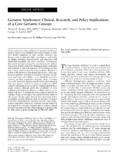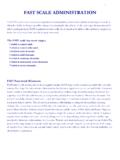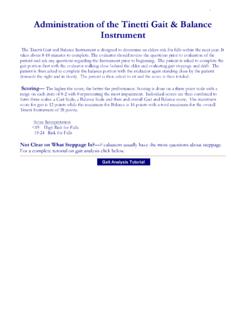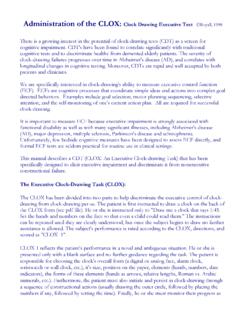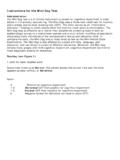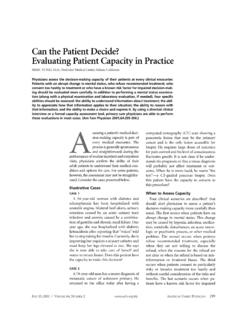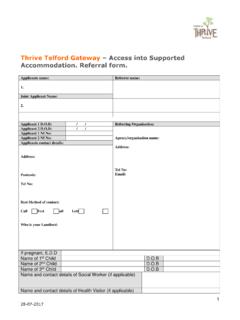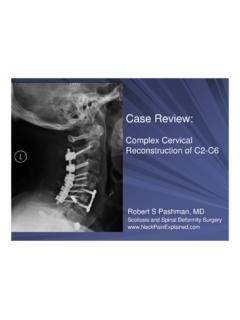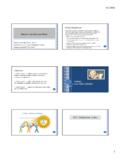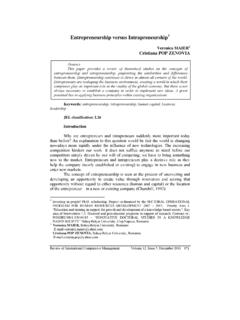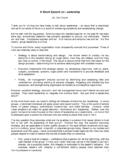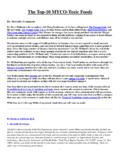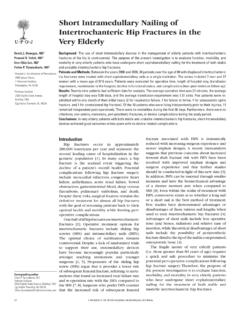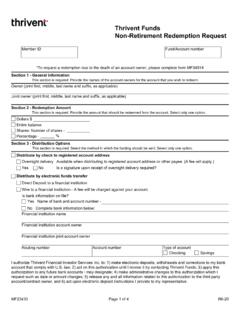Transcription of Palliative Performance Scale (PPS)
1 1 No difficulty either subjectively or objectively. 2 Complains of forgetting location of objects. Subjective work difficulties. 3 Decreased job functioning evident to co-workers. Difficulty in traveling to new locations. Decreased organizational capacity. * 4 Decreased ability to perform complex task, ( , planning dinner for guests, handling personal finances, such as forgetting to pay bills, etc.) 5 Requires assistance in choosing proper clothing to wear for the day, season or occasion, ( pt may wear the same clothing repeatedly, unless super-vised.* 6 Occasionally or more frequently over the past weeks. * for the following A) Improperly putting on clothes without assistance or cueing.
2 B) Unable to bathe properly ( not able to choose proper water temp) C) Inability to handle mechanics of toileting ( , forget to flush the toilet, does not wipe properly or properly dispose of toilet tissue) D) Urinary incontinence E) Fecal incontinence 7 A)Ability to speak limited to approximately 6 intelligible different words in the course of an average day or in the course of an intensive interview. B) Speech ability is limited to the use of a single intelligible word in an average day or in the course of an intensive interview C) Ambulatory ability is lost (cannot walk without personal assistance.) D) Cannot sit up without assistance ( , the individual will fall over if there are not lateral rests [arms] on the chair.
3 E) Loss of ability to smile. F) Loss of ability to hold up head independently. *Scored primarily on information obtained from a knowledgeable informant. Psychopharmacology Bulletin, 1988 24:653-659. Functional Assessment Scale (FAST) Palliative Performance Scale (PPS) Functional Assessment Scale (FAST) A hospice is a program designed to care for the dying and their special needs. Among these services all hospice pro-grams should include: (a) Control of pain and other symptoms through medica-tion, environmental adjustment and education. (b) Psychosocial support for both the patient and family, including all phases from diagnosis through bereavement.
4 (c) Medical services commensurate with the needs of the patient. (d) Interdisciplinary "team" approach to patient care, patient/ and family support, and education. (e) Integration into existing facilities where possible. (f) Specially trained personnel with expertise in care of the dying and their families. GENERAL (NON-SPECIFIC) TERMINAL ILLNESS 1. Terminal condition cannot be attributed to a single spe-cific illness. And 2. Rapid decline over past 3-6months Evidenced by: Progression of disease evidenced by sx, signs & test results Decline in PPS to 50% Involuntary weight loss >10% and/or Albumin < (helpful) ADULT FAILURE TO THRIVE Patient meets ALL of the following: Palliative Performance Scale 40% BMI <22 Pt refusing enteral or parenteral nutrition support or has not responded to such nutritional support, despite adequate caloric intake CANCER Patient meets ALL of the following.
5 Findings of malignany with widespread, aggressive or progressive disease as evidenced by increasing sx, wors-ening lab values and/or evidence of metastatic disease Performance Scale (PPS) 70% further life-prolonging therapy OR continues to decline in spite of definitive therapy Supporting documentation includes: Hypercalcemia > 12 Cachexia or weight loss of 5% in past 3 months Recurrent disease after surgery/radiation/chemotherapy Signs and sx of advanced disease ( nausea, requirement for transfusions, malignant ascites or pleural effusion, etc.) DEMENTIA The patient has both 1 and 2: 1. Stage 7C or beyond according to the FAST Scale AND 2.
6 One or more of the following conditions in the 12 months: Aspiration pneumonia Pyelonephritis Septicemia Multiple pressure ulcers ( stage 3-4) Recurrent Fever Other significant condition that suggests a limited prognosis Inability to maintain sufficient fluid and calorie intake in the past 6months ( 10% weight loss or albumin < gm/dl) Hospice Eligibility Criteria Hospice Card HEART DISEASE The patient has 1 and either 2 or 3. 1. CHF with NYHA Class IV* sx and both : Significant sx at rest Inability to carry out even minimal physi-cal activity without dyspnea or angina 2. Patient is optimally treated (ie diuretics, vasodilators, ACEI, or hydralazine and ni-trates) 3.
7 The patient has angina pectoris at rest, resistant to stan-dard nitrate therapy, and is either not a candidate for/or has declined invasive procedures. Supporting documentation includes: EF 20%, Treatment resistant symptomatic dysrythmias h/o cardiac related syncope, CVA 2/2 cardiac embolism H/o cardiac resuscitation, concomitant HIV disease HIV/AIDS The patient has either 1A or 1B and 2 and 3. 1A. CD4+ < 25 cells/mcL OR 1B. Viral load > 100,000 AND 2. At least one (1) : CNS lymphoma, untreated or refrac-tory wasting (loss of > 33% lean body mass), (MAC) bac-teremia, Progressive multifocal leukoencephalopathy Systemic lymphoma , visceral KS, Renal failure no HD, Cryptosporidium infection, Refractory toxoplasmosis AND 3.
8 PPS* of < 50% LIVER DISEASE The patient has both 1 and 2. 1. End stage liver disease as demonstrated by A or B, & C: A. PT> 5 sec OR B. INR > AND C. Serum albumin < gm / dl AND 2. One or more of the following conditions: Refractory Ascites, h/o spontaneous bacterial peritonitis, Hepatorenal syndrome , refrac-tory hepatic encephalopathy, h/o recurrent variceal bleed-ing Supporting Documents includes: Progressive malnutrition, Muscle wasting with dec. strength. Ongoing alcoholism (> 80 gm ethanol/day), Hepatocellular CA HBsAg positive, Hep. C refractory to treatment PULMONARY DISEASE Severe chronic lung disease as documented by 1, 2, and 3.
9 1. The patient has all of the following: Disabling dyspnea at rest Little of no response to bronchodilators Decreased functional capacity ( bed to chair existence, fatigue and cough) AND 2. Progression of disease as evidenced by a recent h/o increasing office, home, or ED visits and/or hospitalizations for pulmonary infection and/or respiratory failure. AND 3. Documentation within the past 3 months 1: Hypoxemia at rest on room air (p02 < 55 mmHg by ABG) or oxygen saturation < 88% Hypercapnia evidenced by pC02 > 50 mmHg Supporting documentation includes: Cor pulmonal and right heart failure Unintentional progressive weight loss NEUROLOGIC DISEASE (chronic degenerative con-ditions such as ALS, Parkinson s, Muscular Dystro-phy, Myasthenia Gravis or Multiple Sclerosis) The patient must meet at least one of the following criteria (1 or 2A or 2B): 1.
10 Critically impaired breathing capacity, with all: Dyspnea at rest, Vital capacity < 30%, Need O2 at rest, patient refuses artificial ventilation OR 2. Rapid disease progression with either A or B below: Progression from : independent ambulation to wheelchair or bed-bound status normal to barely intelligible or unintelligible speech normal to pureed diet independence in most ADLs to needing major assistance in all ADLs AND A. Critical nutritional impairment demonstrated by all of the following in the preceding 12 months: Oral intake of nutrients and fluids insufficient to sustain life Continuing weight loss Dehydration or hypovolemia Absence of artificial feeding methods OR B.
